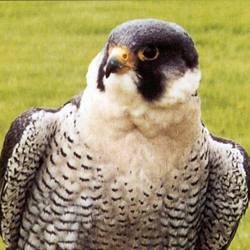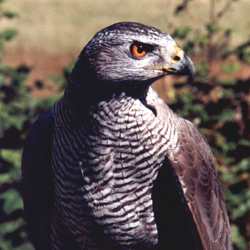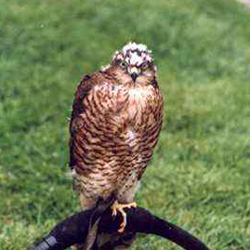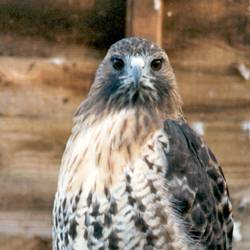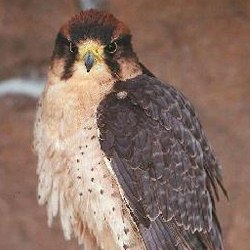
| SPECIES |
|
Not all of the hawks used for falconry in the UK are mentioned below. You will not see Ferruginous Hawks, Lugger Falcons, Common Buzzards, Kestrels, eagles etc. These are the mostly commonly used hawks used by falconers in the BFC (British Falconers' Club) and indeed any other club in the UK. |
|||
|
PEREGRINE (Falco peregrinus) This medium sized, heavily built bird is the archetypal falcon. Preying almost exclusively upon birds, its' powers of flight have captivated falcones for centuries. A worldwide species that declined sharply due to pesticide poising in the 1950's and 1960's, the peregrine has made a good recovery and Britain has the most significant population in Europe. In falconry this species sets the standard against which all other trained falcons are measured. |
GOSHAWK (Accipiter gentilis) This strong and robust hawk has been the mainstay of falconry for many years. Once known as the 'Cooks hawk' because of its' ability to catch a wide variety of quarry for the larder. The goshawk is the shortwing par excellence capable of taking quarry such as pheasant, rabbit and hare. It can be flown in enclosed country and its versatility has made it much coveted. In the 19th century Britain it was persecuted out of existence, however toady it is reestablished with a small but steadily increasing population. |
||
|
Harris Hawk (Parabuteo unicinctus) First trained for falconry in the 1960's the Harris has become very popular. It is intelligent, versatile and naturally sociable. This enables the falconers to build an enviable relationship with the hawk. They come from the southern United States and central America. Predominantly a desert species of raptor they have adapted well to British conditions. |
SPARROWHAWK (Accipiter nisus) A small dashing hawk that was a favourite amongst the ladies in mediaeval nobility. It has great powers of acceleration and maneuverability and is capable of taking quarry up to the size of a magpie or partridge. This is the most common British hawk and can be seen in most country districts. As a falconry bird it is both delicate and temperamental and should be left to the very experienced falconer. |
||
|
Redtail Hawk (Buteo jamaicenis) This North American buzzard has proved to be an excellent falconry bird. It is an aggressive and powerful hunter of rabbit and hare. Whilst closely related to our own common buzzard, the redtail is bigger and more predatory.
|
MERLIN (Falco columbarius) The smallest European falcon, the merlin was the 'ladies falcon' in mediaeval times. It hunts small birds and in its' trained state is used to pursue skylarks. This is done under license from the D.o.E with the number of larks taken strictly controlled. It is small but versatile falcon with the male commonly known as a 'Jack'. |
||
|
Hybrid Falcons ( Gyr X Saker illustrated ) Whilst still the subject of some controversy in UK falconry circles the obvious advantages of hawking with hybrid falcons is born out by the popularity of these hawks with many falconers. The merits of crossing various species of falcon to obtain the best all round capabilities of both the parents can be argued for hours by both the purist and the progressive amongst us. I will not go into the pros and cons of this argument in this short description but would say that this type of hawk should only be considered with falconers with some degree of experience with other longwings. |
Lanner Falcon (Falco biarmiscus). The Lanner is the falcon that most people will usually see at falconry displays around the UK. Slightly smaller than a peregrine they are beautiful falcons with a gentle temperament. Many people interested in flying longwings and Peregrines in particular, gain experience with this this bird as their first falcon. Not many falconers can regularly take quarry with a Lanner but it is probable underestimated as a hunting hawk in the UK. It certainly excels in the arena as a display falcon putting up many stoops to the lure to the delight of the watching crowds. |
||
 |
Countrysports and Country Life is indebted to the British Falconers Club (BFC) for allowing us to publish the photographs and details of the most commonly used hawks used in British Falconry. We recommend anyone interested in falconry to visit their site at http://www.britishfalconersclub.co.uk |
